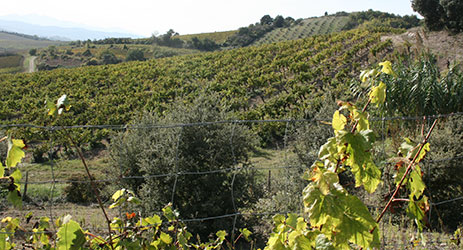Jefford on Monday
‘There’s an island spirit here,’ said Gérard Bertrand’s viticulturalist Richard Planas, as we toured Limoux together. ‘It’s an island inside a continent.’ ‘If Languedoc was Australia,’ – Jean-Louis Denois took the metaphor a little further – ‘we would be Tasmania.’

All that’s missing is encircling seawater. Instead, the cool Limoux shoreline is defined by altitude (no vineyard lower than 280m, and some which crest 500m), aspect (more east- and west-facing aspects than southerly ones) and wind (from the north-west). It’s a substantial wine island, though: Limoux in fact has four times as much land under vineyard as Tasmania (7,800 ha compared to 1,800 ha).
Most of that, of course, is used for the often admirable sparkling wines I wrote about last November, and which claim sixteenth-century antecedents. There are, though, still wines here too, of much more recent date. Production levels may be smaller (under 250 ha) but there is much to intrigue the curious drinker.
What most wine lovers know about Limoux’s whites, in part thanks to the success of the co-operative Sieur d’Arques ‘Toques et Clochers’ charity auction, is that the appellation regulations require them to be barrel-fermented. This innovation dates from the revision of Limoux’s still-white-wine AOC in 1993, the same moment at which Chenin and Chardonnay joined the traditional Mauzac as approved varieties, and was a brave move, given the cost implications. In the early years, it did indeed result in some over-oaky whites, but since neither the age of the oak nor the size of the barrel is specified, that moment has passed: you could use five-year-old 600-litre casks if you want, and the oak would be barely palpable. (Some in the region are agitating to have this requirement abandoned.)
It’s those varietal possibilities, in fact, rather than barrel fermentation which gives Limoux whites their key interest and confirms their ‘island’ status: no one else in southern France can do anything remotely similar while still producing appellation wine.
Most choose to work with Chardonnay. If you can imagine Chablis with a bigger bone structure mixed with 20 per cent dry Jurançon, you won’t be far off the best: their acid structure is definitely to the fore, but the sun of south develops more overt fruit flavours than you get further north. Gérard Bertrand’s Domaine de l’Aigle (once an investment by Burgundy’s Antonin Rodet) provides a benchmark, though the high-altitude, prestige Aigle Royale seems a little overworked and in 2013 I prefer the straight Limoux Chardonnay. Denois’ own Domaine de la Borde Longue may well be the finest crafted of all (the 2012 Sainte Marie is balanced, vinous and classical), and the chance to taste a small vertical of Chardonnays from Domaine de Mouscaillo showed that Limoux whites can age well: the 2006 and 2011 were both poised, fresh, pithy whites, impressively preserved.

Personally, I’m less impressed with the Chenin Blanc whites, though local growers love the variety’s acid-retention abilities ( ‘it can take you 500 km north of here, ’ says Denois, as well as ’dissolving the taste of the barrique’). A pure-Mauzac is an act of daring, as it’s not easy to sell, but the two I tried on my visit were both fascinating: the 2013 Occitania from Rives Blanques was far more complex than the ‘appley’ reputation of Mauzac would suggest (green plum and summer vegetables, as well as some welcome cream from lees contact), while former rugby-player Franck Schisano’s 2012 Consolament was no less impressive, though more secondary, with a vinous, almost honeyed palate, showing the expressive width of the variety. Blends, too, can be exciting, especially Rives Blanque’s prestige La Trilogie: the 2012 was subtle and complete as well as lively and svelte – and how often can you say that about a Languedoc white?
When you come to the red wines of Limoux, though, this is an island in scission, like Cyprus. The red AOC dates from 2004, and came into being thanks to the elegant, kid-gloved clout of the late Baroness Philippine de Rothschild, who had purchased an estate at St-Polycarpe (re-named Baron’arques), initially to make red wine. It seemed to the Rothschild team that the kind of Atlantic-Mediterranean hybrid blend also used in nearby Cabardès and Malpére was right for Limoux: the final mix chosen was 50 per cent Merlot mixed with Malbec, Syrah and Grenache (30 per cent minimum) and smaller quantities of the two Cabernets and Carignan. The red wines of Baron’arques have been excellent: real finesse from the Languedoc, where that can be an elusive quality, though they are very hard wines to place in a blind tasting.
Other growers, though, increasingly favour Pinot Noir for still red Limoux – despite the fact that this has to go to market as IGP Haute Vallée de l’Aude. ‘If we were doing the appellation regulations all over again,’ says Richard Planas, who worked on drawing up the original set of rules, ‘I would make Limoux Rouge a Pinot Noir AOC’. The singing quality of Pinot Noir fruit in Limoux can be impressive, and the wines are authentically pale, poised, fresh and lively: perhaps the best shot with this variety from anywhere in France south of the Chalonnais (with more depth and tenacity than most examples from the Auvergne, and better natural articulation than Corsican Pinot). Aigle and Mouscaillo both make good examples.
I have two reservations about both Limoux whites and Haute Vallée de l’Aude Pinot Noirs, though. The first is that they are often over-acidic and lack balancing softness and charm. (Maybe this is because producers are accustomed to seeking and sustaining acidity levels for sparkling base wines, which need an edgier balance than still wines.)
And the second is the quality they share, in fact, with many other Languedoc wines: a faintly bitter finish. In a classic Languedoc red, this either passes unnoticed, or is liked, since it is easy to assign it to the ‘herbal, garriguey’ side of the Languedoc character. In the high-altitude, fruited limpidity of Limoux, though, a bitter note tends to stand out more, or bond ungratefully with the pronounced acidity. These attractive wines would be better off without both of these minor blemishes.
Translated by Sylvia Wu / 吴嘉溦
All rights reserved by Future plc. No part of this publication may be reproduced, distributed or transmitted in any form or by any means without the prior written permission of Decanter.
Only Official Media Partners (see About us) of DecanterChina.com may republish part of the content from the site without prior permission under strict Terms & Conditions. Contact china@decanter.com to learn about how to become an Official Media Partner of DecanterChina.com.



Comments
Submit